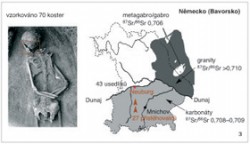Závěrečné pokračování příspěvku představuje řadu příkladů využití stabilních izotopů při studiu výživy a migrace lidí (např. délka kojení, konzumace kukuřice v Severní Americe, původ obyvatelstva v Bavorsku, migrace v Egyptě apod.).
Balasse, M., Tresset, A., Ambrose, S.H. (2006): Stable isotope evidence (δ13C, δ18O) for winter feeding on seaweed by Neolithic sheep of Scotland. Journal of Zoology. 270.170-176.
Bentley, R.A., Knipper, C. (2005): Geographical patterns in biologically available strontium, carbon and oxygen isotope signatures in prehistoric SW Germany. Archaeometry 47 , 3 (2005) 629–644.
Buchardt, B., Bunch, V., Helin, P. (2007): Fingernails and diet: stable isotope signatures of a marine hunting community from modern Uummannaq, North Greenland. Chemical biology. 244. 1-2.316-329.
Buzon, M., Simonetti, A., Creaser, R.A. (2006): Migration in the Nile Valley during the New Kingdom period: a preliminary strontium isotope study. Journal of Archaeological Science. 34. 9.1391-1401.
Clayton, F., Sealy, J., Pfeiffer, S. (2006): Weaning Age Among Foragers at Matjes River Rock Shelter, South Africa, From Stable Nitrogen and Carbon Isotope Analyses. American Journal of Physical Anthropology. 129.311–317.
Dittmann, K. et Grupe, G. 2000: Biochemical and paleopathological investigation on weaning and infant mortality in the early Middle Ages. Anthropologischer Anzeiger. 58. 345-355.
Fuller, B.T., Molleson Tim Harris, D.A., Gilmour, L.T., Hedges, R.E.M. (2006): Isotopic Evidence for Breastfeeding and Possible Adult Dietary Differences From Late/Sub-Roman Britain. American Journal of Physical Anthropology. 129.45–54.
Herring, A., Saunders, S.R., Katzenberg, M.A. 1998: Investigating the Weaning Process in Past Populations. American Journal of Physical Anthropology. 105.425–439.
Kendall, C., Doctor, D.H. (2004): Stable isotope applications in hydrologic studies, in Drever, J.I., ed., Surface and ground water, weathering, and soils: Treatise on Geochemistry, v. 5, p. 319-364.
Muller, W., Harke, H., Grassineau, N. (2006): Analysis of Early Medieval Human Migrations in Central Europe (research proposal) http://www.gl.rhul.ac.uk/research/resops/PDF_opps/2008/WM_migration_Europe_2007.pdf
Nardoto, G.B., Silva, S., Kendall, C., Ehleringer, J.R., Chesson, L.A., Ferraz, E.S.B., Moreira, M.Z., Ometto, J.P.H.B., Martinelli, L.A. (2006): Geographical patterns of human diet derived from stable-isotope analysis of fingernails. American Journal of Physical Anthropology. 131. 137-146.
Ramsl, P.C. (2004): Migration phenomena in the early La Tène period. Antiquity. 78. 299 http://www.antiquity.ac.uk/projgall/ramsl/index.html
Reber, E.A. et Evershed, R.P. (2004): How did Mississippians prepare maize? The application of compound-specific carbon isotope analysis to absorbed pottery residues from several Mississippi valley sites. Archaeometry. 46. 19–33.
Richards, M.P., Mays, S., Fuller, B.T. (2002): Stable Carbon and Nitrogen Isotope Values of Bone and Teeth Reflect Weaning Age at the Medieval WharramPercy Site, Yorkshire, UK. American Journal of Physical Anthropology. 119. 205–210.
Schurr, M.R., Powell, M.L. (2005): The Role of Changing Childhood Diets in the Prehistoric Evolution of Food Production: An Isotopic Assessment. American Journal of Physical Anthropology. 126. 278–294.
Schurr, M.R. (1997): Stable isotopes as evidence for weaning at the Angel site: a comparison of isotopic and demographic measures of weaning age. Journal of Archaeological Science. 24. 919–927.
Schweising, M.M., Grupe, G. (2003): Stable strontium isotopes in human teeth and bone: a key to migration events of the late Roman period in Bavaria. Journal of Archaeological Science. 30. 1373-1383.
Smrčka, V. (2005): Trace Elements in Bone Tissue. Karolinum. Praha
The final part of this contribution presents some examples of using stable isotopes in studying food and migration patterns in human populations (e.g. length of the lactation period, maize consumption in North America, Bavarian population origin, migration in Egypt, etc.).
 Gradient poměru izotopů stroncia (87Sr/86Sr) v různorodém geologickém substrátu území Bavorska. Schéma upraveno podle M. M. Schweissing a G. Gruppe (2003). Orig. L. Kovačiková a J. Brůžek / © L. Kovačiková a J. Brůžek
Gradient poměru izotopů stroncia (87Sr/86Sr) v různorodém geologickém substrátu území Bavorska. Schéma upraveno podle M. M. Schweissing a G. Gruppe (2003). Orig. L. Kovačiková a J. Brůžek / © L. Kovačiková a J. Brůžek



